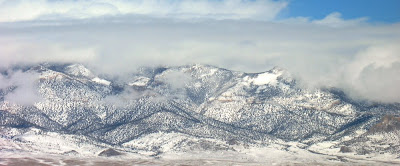What are the places and events that you think should all geologists should see and experience before they die? What are the places you know and love that best exemplify geological principles and processes?Rather than create a new list of 100, or even 25, I thought I'd just mention a few places not on the original list, that I think should be considered.

Snake Range, Nevada: a place to collect mylonites.
1. See a metamorphic core complex - metamorphic core complexes are common in a belt in North America, from British Columbia south into Mexico, and also occur in other places in the world, including Slovakia, Greece, Turkey, Iran, Tibet, China, and New Zealand. One should see a metamorphic core complex, preferably as part of a tour or field trip, just so one can get involved in the lively discussions about how they form, but also in order to see and collect wonderful samples of mylonites!2. While in Tibet, check out the Tibetan Plateau - just because it's there. It's the "largest, highest area in the world today" - and it was created by a magnificent convergence of two continental plates.
3. While in China, be sure to see the South China Karst, which is now a UNESCO World Heritage Site, and which contains some unusual rock formations formed by dissolution and re-precipitation of limestone: Guizhou Libo Karst, Yunnan Shilin Karst, and Chongqing Wulong Karst. I don't know of other similarly magnificent regions of karst that could replace this one.
Those are my three additions or suggestions. I have seen number one: several metamorphic core complexes in the western United States.
Accretionary Wedge #16: Is One Life Enough?
6 comments:
I've been to the Greek one on the island of Naxos, sampling the schists & marbles across the island. The Cyclades are great for geology, as there are also stunning blueschists on Syros and volcanic Santorini/Thera is only a short boat trip away.
Ooh, blueschists are neat rx! I think because of this Wedge I will learn more about geology around the world. Which is a good thing!
is it correct if i say that i have been to texes and USA?
your geographic knowledge and way you describe places brought you back to the Permian period where there is no boundary of land, can i tell you that i have been to hawaii and the USA? same thing when you say that "...Tibet and China..."
Yes, it is perfectly correct to say that you have been to Texas and to the U.S. Likewise with Hawaii. Also, if you'd said you'd been to Alaska, there are many who wouldn't realize that you had also been to the U.S. at the same time. Most Alaskan's find this immensely funny. I did not enter into any political commentary here. If you follow the link for the first "Tibet," you will find the article says "Xizang (Tibet)."
While in Mexico, you might go to Mexico City; while in the Yucatan, you might go to Mérida.
Relax a little.
OK, no politics, thats why we are here in science blog as oppose to political blogs, can i ask a question, are all accretionary complexes granites of S-Type?
You can ask, but I don't know the answer off the top of my head. Google could help you with that answer.
The Accretionary Wedge mentioned and linked to in this post is a blog carnival, a gathering of posts by many in the GeoBlogosphere, on one particular chosen subject. It's a monthly carnival.
It is common practise when commenting on blogs to keep to the subject of the blog post, btw.
Post a Comment